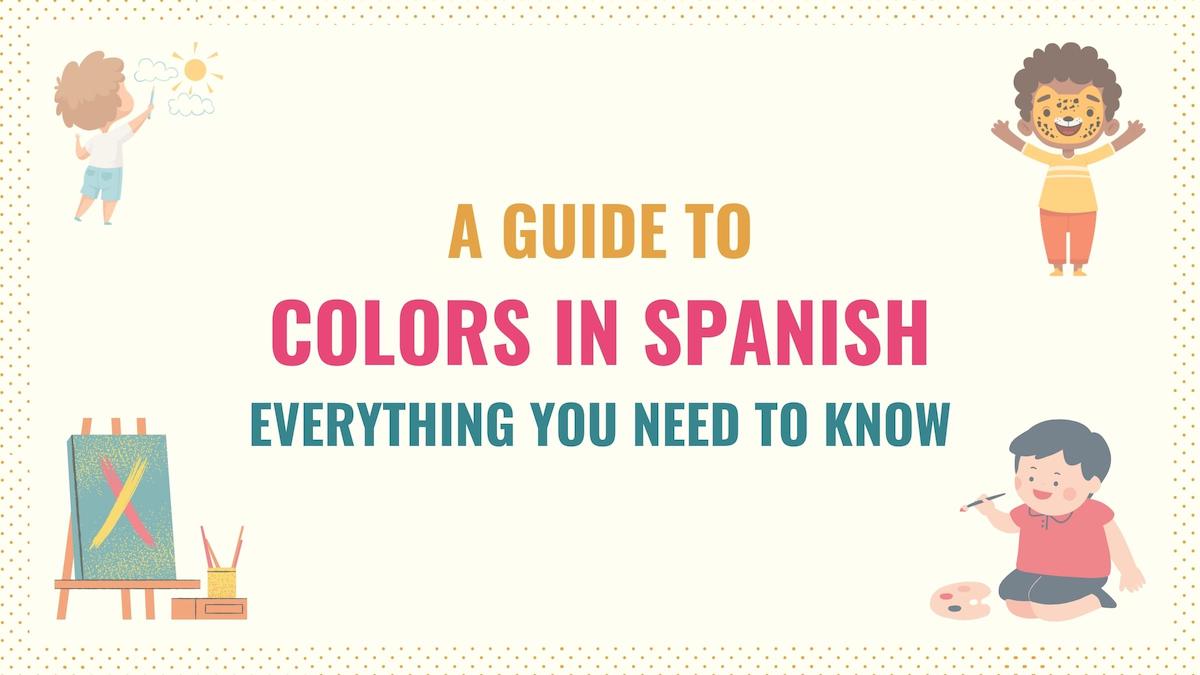Believe it or not, Spanish colors are part of an essential set of words that we use in our daily conversations.
Since colors in Spanish are really useful, in this guide, I’ll teach you the most important terms that you need to know. I’ll also include some rules that you need to know to apply these words correctly as well as some examples so you have a better idea of how to include this vocabulary in your conversations.
Guide Contents
- Common Colors in Spanish
- Hair Colors
- Eye Colors
- Rules for Colors in Spanish
- Spanish Words to Describe a Color
- Spanish Idioms with Colors
- Key Points
By the end of this, not only will you know how to say all of the colors in Spanish, but you’ll be able to use them like a native speaker!
The Colors in Spanish: List of Basic Colors
Since today they’re many combinations and shades, when starting to learn the language, many people wonder what are the basic colors in Spanish.
List of colors in Spanish:
| Spanish color | English color |
|---|---|
| Amarillo | Yellow |
| Anaranjado / Naranja | Orange |
| Azul | Blue |
| Blanco | White |
| Café / Marrón | Brown |
| Gris | Gray |
| Morado | Purple |
| Negro | Black |
| Rojo | Red |
| Rosa | Pink |
| Verde | Green |
In Spanish, these terms can be used to talk about someone’s color preferences or to explain what color something is.
(Determiner) + [color] + [complement]
A mí no me gusta el amarillo.
I don’t like yellow.
El vestido de Suzy es verde esmeralda.
Suzy’s dress is emerald green.
El rosa y el azul son mis colores favoritos.
Pink and blue are my favorite colors.
Mi camisa es blanca y mis zapatos son negros.
My shirt is white and my shoes are black.
¿Has visto una botella de agua amarilla?
Have you seen a yellow water bottle?
Hair Colors in Spanish
As mentioned earlier, the colors that you learned before are meant to describe objects. In Spanish, we use slightly different vocabulary when referring to someone’s hair.
These are the most common hair colors in Spanish:
- Canoso – Grey-haired
- Castaño – Chestnut / Brown / Brunette
- Rubio – Blond
- Güero – Blond (Mexican slang)
- Negro – Black
- Pelirrojo – Redheaded
- Rojo – Red
Here are some examples of how to use hair colors in Spanish.
[Verb conjugated] + [color] + (adjective)
Mi cabello es largo y negro.
My hair is long and black.
Letty se quiere pintar el cabello rojo.
Letty wants to dye her hair red.
Creo que Paola tiene el cabello castaño claro.
I think Paola has light chestnut hair.
La novia de Paco tiene el cabello muy güero.
Paco’s girlfriend has very blond hair.
El cabello de Lexi es rubio platino.
I think Lexi’s hair is platinum blond.
Take Note: Güero is a Mexican slang word that, on top of referring to blond hair, can also be used as a nickname for blond or white people.
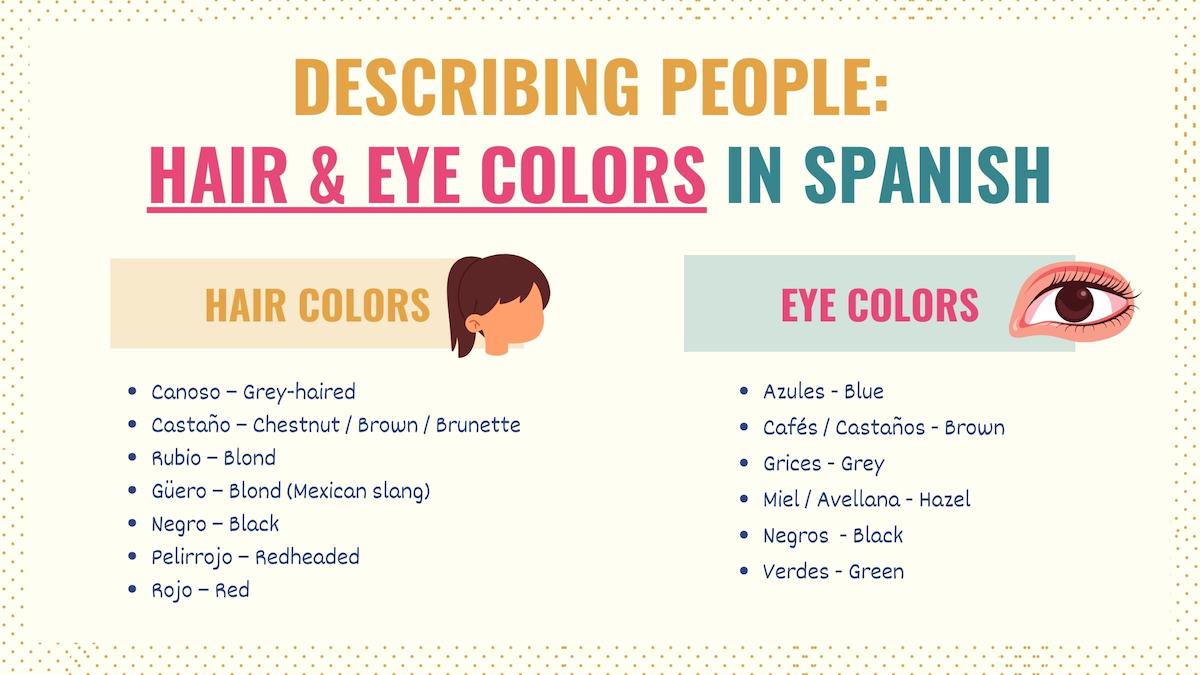
Eye Colors
Although some basic Spanish colors might be used in this context, when describing a person’s eyes, there are other colors that you also need to learn. Notice that, in Spanish, the word ojos (eyes) is plural. So, in this context, the colors you use will necessarily need to be pluralized.
Here are some of the most common eye colors we use in Spanish:
| Spanish color | English color |
|---|---|
| Azules | Blue |
| Cafés / Castaños | Brown |
| Grices | Grey |
| Miel / Avellana | Hazel |
| Negros | Black |
| Verdes | Green |
When it comes to describing a person’s eyes, you can use two different phrase structures.
[Subject] + [‘tener’ conjugated] + los ojos + (adj) + [color]
Tus primas no tienen los ojos azules.
Your cousins don’t have blue eyes.
Katarina tiene ojos grandes y negros.
Katarina has big black eyes.
Mi bisabuela tenía los ojos de color miel.
My great-grandmother had hazel eyes.
¿De qué color son tus ojos? Parecen verdes.
What color are your eyes? They seem green.
If instead, you want the word ojos to be the subject of the sentence, you can use this structure. Now, in this case, you’ll need to use Spanish possessive pronouns.
[Possessive pronoun] + ojos + [‘son’ conjugated] + [color]
Mis ojos son cafés.
My eyes are brown.
Tus ojos son muy grises.
Your eyes are very gray.
Bruno es alto y rubio. Sus ojos son grandes y azules.
Bruno is tall and blond. His eyes are big and blue.
Related Resource: Adjectives to Describe Someone in Spanish
Rules for the Colors in Spanish
Although learning these terms may not seem very challenging, there are certain rules that you need to keep in mind if you want to apply these words correctly. So, let’s see some grammar tips that you should follow.
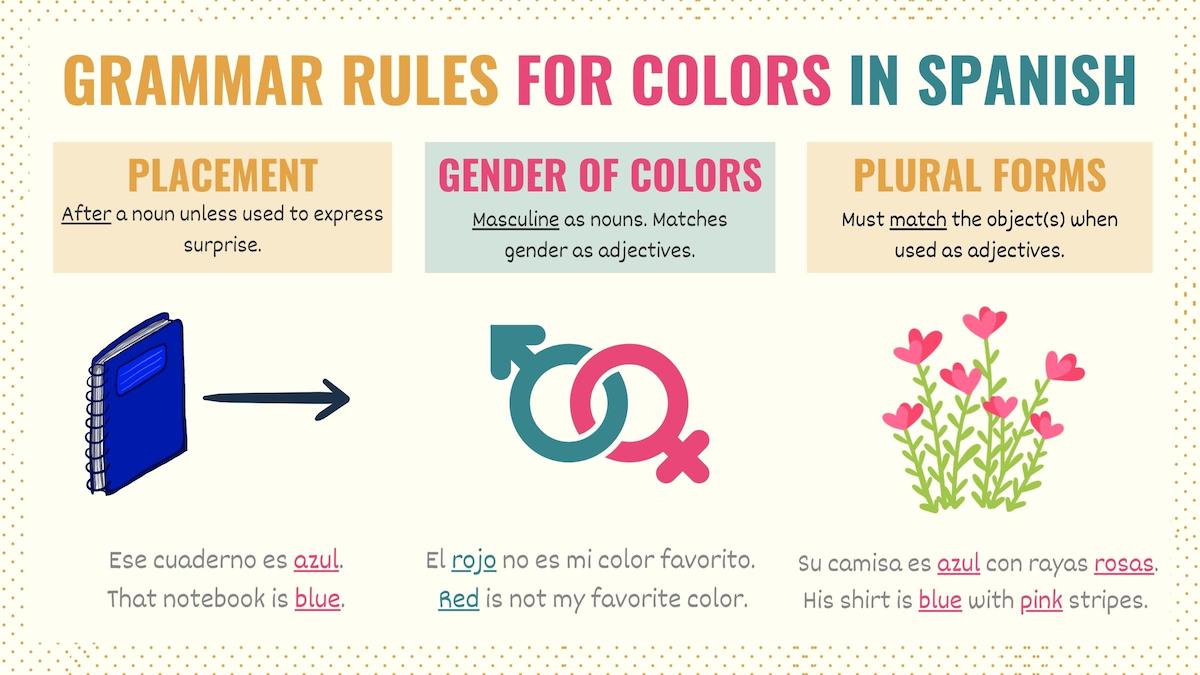
If you pay attention to the examples below, most of the time Spanish colors are placed after the nouns they qualify. Check this:
[Noun] + [color]
Ese cuaderno es azul.
That notebook is blue.
Me compré unos lentes rojos.
I bought some red glasses.
Mónica perdió su blusa rosa.
Mónica lost her pink blouse.
¡Qué ojos tan verdes tienes!
You have such green eyes!
But sometimes in conversational Spanish, the color can be placed before the noun if your sentence is working as an expression of surprise. Check these examples below:
¡Qué + [color] + [verb conjugated] + [noun]
¡Qué azules tiene los ojos!
Her eyes are so blue!
¡Qué negros están los plátanos! ¡No te los comas!
The bananas are so black! Don’t eat them!
Do Spanish colors have gender?
Spanish colors are masculine if they are working as nouns. However, if they are describing an object (adjectives), their gender will change to match the number and gender of the thing that they are describing. This is not applied to words that end with consonants, ‘e’ or ‘a’.
Oftentimes, people wonder how Spanish gender affects a color. The thing is that if you’re using these words as nouns, without exception, they’ll always be masculine. To put it in “non-grammar-freak” words, if the color is the subject (the main focus) of your sentence, then, it’s a masculine noun.
Here are some examples of Spanish colors working as nouns. Notice that, in this context, you’ll use masculine definite articles or demonstrative adjectives.
[Determine] + [color] + [verb conjugated] + [complement]
El rojo no es mi color favorito.
Red is not my favorite color.
Este verde está muy feo, ¿buscamos otro tono?
This green is very ugly, should we look for another hue?
Celine me dijo que el rosa combina con el gris.
Celine told me that pink goes well with gray.
In Spanish, if a color is working as an adjective, it must mark the gender and number of the object it’s describing. For instance, rojo (red) becomes rojas when referring to a plural feminine noun.
This doesn’t apply to colors that end with ‘e’, consonants, or ‘a’. Examples of this include colors like ‘rosa’, ‘marrón’, ‘verde’, ‘gris’, or ‘azul’.
[Noun] + [verb conjugated] + [color]
Creo que el cuaderno era rosa.
I think that the notebook was pink.
Mi teléfono es morado y mi bolsa roja.
My phone is purple and my bag red.
La camisa de Benny es azul con rayas rosas.
Benny’s shirt is blue with pink stripes.
Take Note: When it’s clear what object you’re describing or referring to, you can omit the noun and simply use the corresponding definite article and the color that would best describe it.
| Spanish | English |
|---|---|
| Tú: ¿Qué camisa te gusta? | You: What shirt do you like? |
| Tu amigo: La azul. | Your friend: The blue one. |
Describing a Color in Spanish
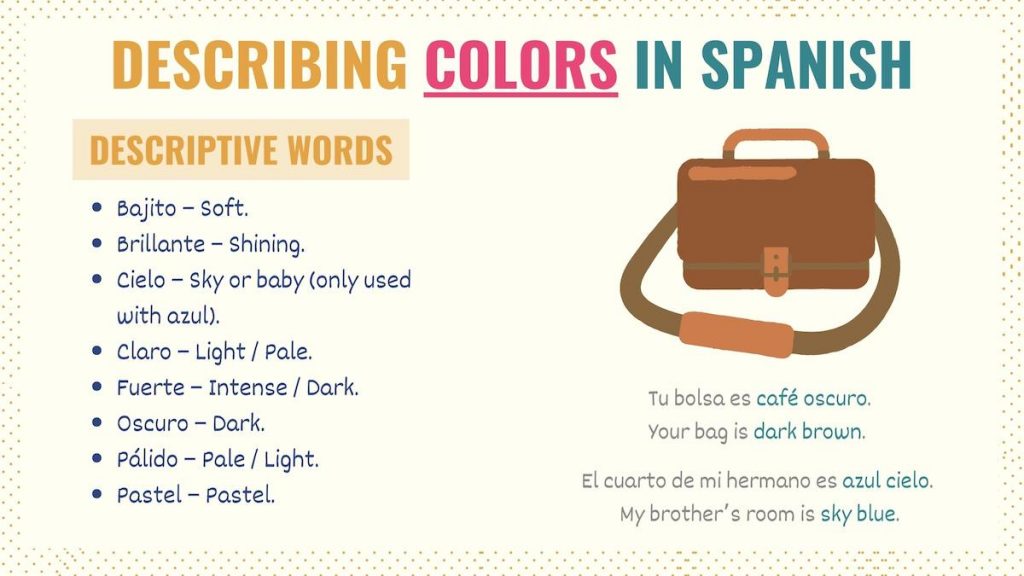
Colors in Spanish can help you describe different objects and things. However, they can also be described. So, if you want to be more specific, there are certain words that will allow you to specify the shade or color tone that you’re talking about.
Some common words that you can use to explain how a color is include:
- Bajito – Soft.
- Brillante – Shining / Bright.
- Cielo – Baby. Only used with azul.
- Claro – Light / Pale.
- Fuerte – Intense / Dark.
- Oscuro – Dark.
- Pálido – Pale / Light.
- Pastel – Pastel.
Here are some examples of how to use these adjectives to talk about a color:
Tu bolsa es café oscuro.
Your bag is dark brown.
A Cindy le gusta el rosa pastel.
Cindy likes pastel pink.
Este tono de azul es muy brillante.
This shade of blue is too bright.
El cuarto de mi hermano es azul cielo.
My brother’s room is baby blue.
Mis lentes son morado bajito.
My glasses are light purple.
Notice that in this situation where you’re using adjectives to describe different shades, Spanish colors will remain singular.
Spanish Idioms with Colors
This vocabulary isn’t only helpful to describe objects. In fact, there are some common Spanish idioms that you could include in your conversations and that will help you sound more natural when speaking Spanish.
Ponerse rojo como un tomate is used to describe that a person is blushing because he or she is embarrassed about something. This standard idiom is close in meaning to ‘to blush’ or ‘red as a beetroot’.
Sacar canas verdes is a Latin American Spanish phrase. It is used to describe that someone is upsetting or making another person worried because of their actions. It can be translated as ‘turn someone’s hair gray’.
Estar verde is an informal expression that is used to describe that a person has no experience with something. It can also be used to express that a person, vegetable or fruit is not mature. It means ‘to be green’, ‘to be unripe’ or ‘to be new at something’.
Quedarse en blanco means that a person forgot something or that he or she has no more ideas. This expression can be translated as ‘to go blank’.
Dar luz verde is an informal expression that means that someone gave his or her permission to do something. It is the direct translation of ‘to give the green light’ or ‘to give the go ahead’.
Key Points
Since they can be applied in daily conversations, colors are an essential part of the Spanish vocabulary that you need to know.
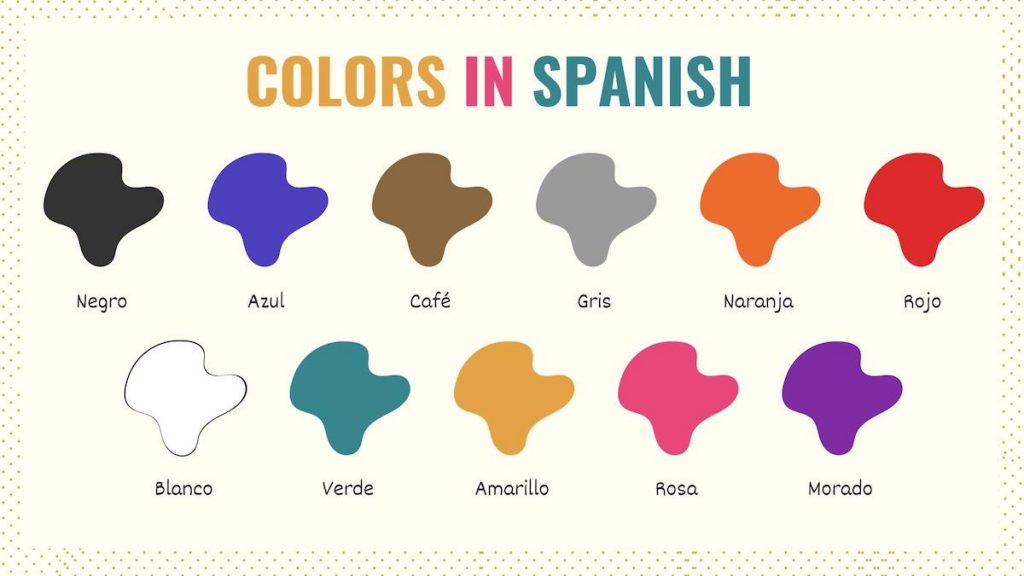
When it comes to Spanish colors, here are some key points to keep in mind:
- If working as a noun, a color in Spanish is always masculine.
- A color working as a noun is preceded by Spanish definite articles or demonstrative adjectives.
- When describing an object, colors need to match the gender and number of the object.
- Colors that already end with ‘e’, consonants or ‘a’ do not change their gender.
- As adjectives, colors are placed before the noun that they’re describing.
- To describe different shades or the intensity of a color, we use adjectives. In this case, the color will always remain singular.
Now, you have everything you need to know to start incorporating these words into your daily life conversations. ¡Buena suerte!
Additional Resources to Learn Spanish Adjectives
Here are some additional links that can help you improve your Spanish. An adjective is a crucial part of your sentence. So, you should study what an adjective is and how to use it. If you’re interested in learning more words like these, I suggest you learn common adjectives.
As mentioned through the article, a color can change its gender and number when working with nouns. In this link, you’ll learn more information about adjective agreement in Spanish.
Download the Spanish Colors PDF
Talking about the color of objects is one of the most fundamental skills you need to know in a language. I’ve created a PDF you can download for free with all the graphics and key points from this guide.

